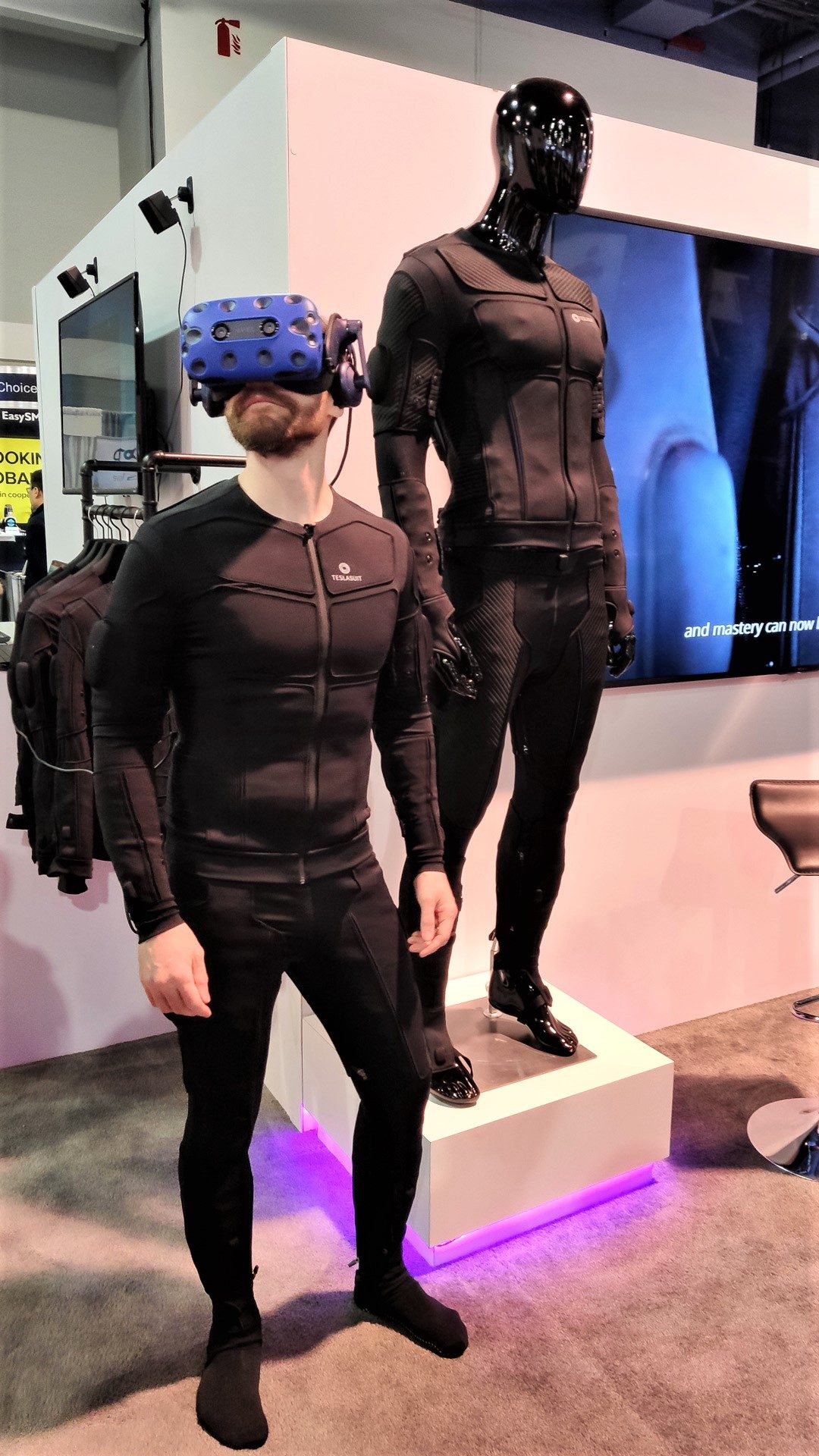Teslasuit is a London-based company that makes an enterprise-focused haptic suit like none other I’ve experienced thus far. I got a chance to go hands-on at CES 2020 this week to find out just what sets it apart from other haptic suits, many of which employ a series of vibrating motors in an attempt to simulate the sense of touch. Teslasuit is different though. In homage to Nikolai Tesla’s advances in electricity, Teslasuit delivers to the body a range of amperage that’s designed to leave a lasting impression.
Stripping down to my skivvies and putting on a skin-tight suit wasn’t something I’ve ever done before on a trade show floor. After all, Teslasuit isn’t an overgarment; you need direct skin contact with the electro-woven smart neoprene jacket and trousers to effectively deliver electric stimulation across the suit’s 80 independent channels, which covers most of the body. Although previous models of the suit featured thermal feedback, the suit I tried out at CES 2020 only showcased electro-stimulation as its sole haptic.

The model I tried out also included IMU-based motion capture and a host of biomedical gubbins like electrocardiogram (ECG) and galvanic skin response sensors to capture user vitals, something that positions the suit as a pseudo medical device for diagnostics when taking part in training and simulation exercises.
Before I could pop on the HTC Vive Pro and get into a training simulation though, I first went through a five-minute calibration process that tested out what level of electro-stimulation I could mentally handle on each part of my body, which included conductive sites snuggly placed on the front and back of both legs, on my chest, shoulders, back, arms and forearms.
The very minimum level felt like a gentle tickle while the max amperage delivered a genuinely surprising jolt that instantly contorted each underlying muscle. Although it wasn’t painful, it certainly got my attention in a way that even the most aggressive haptic motor-based suit never has. Leaving an impression is the whole point, Teslasuit co-founder and CRO Dimitri Mikhalchuk tells me.
VR & Electo-stimulation: a Potent Combination
When it comes to training someone to do something dangerous, the act of being mildly electrocuted is designed to provide enough of a real world consequence to not only keep trainees on their toes during their VR session, but to more effectively enter the virtual training experience into the user’s memory. It’s about creating higher fidelity recall and better skill transfer, Mikhalchuk says, something that he says works in virtual boxing, police training, firefighting, and other activities where real physical harm can occur.
Teslasuit isn’t designed to be purely punitive in nature, although it creates ersatz punches, gun shots and explosions particularly well. That tickling sensation I mentioned before actually does a pretty good job of replicating a gentle rain, which in my case was an oil leak spraying into the air and falling down on my shoulders as I attempted to avert disaster aboard an offshore oil rig gone awry.
The suit’s ability to replicate some sensations was much less convincing though; a mild, extended jolt was applied to both arms as I wrenched a series of valves closed, which I imagine was supposed to stand in for the physical resistance I would have otherwise felt with a physical valve. That said, it seems Teslasuit performs best in the extremes—and the demo’s ending provided one such example.
I had, through no fault of my own, failed my mission to properly shut down the rig’s manual safety system and then suddenly the whole thing exploded. I’m no stranger to failing disastrously in VR games, but witnessing a giant explosion and getting a strong muscle-tensing shock throughout my entire body—well, that’s something I won’t be forgetting any time soon.
The Mother of Invention
Teslasuit is targeting a few industries such as public safety, athletics, physical rehab, and enterprise training, and there’s a few good reasons why at this point. The company hasn’t publicly published its prices, however back in 2016 when it first launched its Kickstarter, it was going for around £1,800 ($2,300 USD), which should give you an idea of the price range. That’s perhaps less relevant to the overall technology though.
For one, the suit is cumbersome to put on and take off, which isn’t great in really any context but the most determined of use cases. I personally began sweating immediately once I put it on, which made taking it off quite the challenge, as it easily sticks to your skin. It isn’t one-size-fits-all either, so multiple suits are required to offer a range of sizes to users. To that end, suits were constantly being steam-cleaned throughout the day to set up for the next guest, which is a clear necessity when the last person was just sweating it out in your suit.
In the end, I’m still skeptical whether the ends truly justify the means here, although business seems to be going well enough for Teslasuit. Now at over 150 employees, the company is looking forwards to welcoming another 50 soon, which only shows just how determined the company is to disperse its unique and interesting haptic technology across the enterprise space.
Update (January 11th): It was previously mentioned that Teslasuit’s electro-stimulation haptics only included neuromuscular electrical stimulation (NMES) when it actually also includes transcutaneous electrical neural stimulation (TENS), both of which I refer to as simply ‘electro-stimulation’ for the purposes of this article. I look forward to spending more time with Teslasuit at future shows to get a better understanding of the differences as they apply to the haptic suit itself.
A special thanks goes out to David Parisi for pointing this out.







